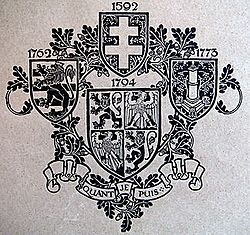Colleges of St Omer, Bruges and Liège facts for kids
Quick facts for kids Colleges of St Omer, Bruges and Liège |
|
|---|---|
 |
|
| Location | |
| Information | |
| Type | Roman Catholic (Jesuits) |
| Established | 1593 (St Omer), 1762 (Bruges), 1773 (Liège) |
| Founded by | Father Robert Parsons SJ |
| Succeeded by | Stonyhurst College |
The Colleges of St Omer, Bruges and Liège were important schools for English Catholic students. They were run by a religious group called the Jesuits. These schools were set up outside England because, at the time, it was hard for Catholics to get a good education in their home country.
The first school started in 1593 in a place called Saint-Omer (which was then part of the Spanish Netherlands). It was founded by Father Robert Parsons SJ. Later, the schools had to move twice. This happened because the Jesuit order was banned in France.
In 1762, most teachers and students moved to Bruges. Then, in 1773, they moved again to Liège. A smaller school stayed behind in St Omer. Finally, in 1794, the school in Liège moved one last time to Stonyhurst in England. This new school became what is now Stonyhurst College.
Contents
Starting the Schools
During the time of Queen Elizabeth I, there were strict laws in England against Roman Catholics. These laws made it difficult for Catholics to get a religious education. Because of this, English Catholics started colleges in other European countries. Some of these were the English College, Douai and the English College in Rome. Most of these colleges were for training priests.
Father Robert Parsons (1546–1610) helped start one of these colleges in Spain. But he also saw a need for a school for young Catholic boys who weren't planning to become priests. He chose Saint-Omer because it was close to England. It was also ruled by Catholic Spain and was near the University of Douai, where important Catholic scholars worked.
The first school, the English Jesuit College at St Omer, opened in 1593. The King of Spain, King Philip, even supported it directly from 1599. The school grew and did well for a while. However, during the English Civil War, fewer students came from England. The number of students dropped a lot by 1645. But once things settled down in England, the school got more students and became strong again.
Under French Rule
In 1658, Spain gave St. Omer to France. The French kings were also Catholic and supported the school, just like the Spanish kings had. In the early 1700s, two fires damaged the town and the college. But each time, the school was rebuilt and even made bigger. Some of the buildings from the 1720s were still used many years later. During World War I, they even served as a military hospital.
The college was most successful between about 1720 and 1762. At that time, students in England had to promise to support the Church of England to attend universities like Oxford and Cambridge. So, St. Omer became a key place for English Catholics to get a good education. Even wealthy Catholic families from the American colonies sent their sons to St Omer.
Moving to Bruges, Liège, and Stonyhurst
In 1762, the French government officially forced the Jesuits to leave France. This event caused the college to decline and eventually close. The Jesuit teachers and many students quickly moved to the Austrian Netherlands (which is now part of Belgium). They first went to Bruges. Then, in 1773, they moved to Liège. There, the school was protected by the local Bishop of Liège.
King Louis XV kept a college running in St. Omer, but it was no longer run by the Jesuits. When the Jesuit order was completely banned everywhere in 1773, the school in St. Omer never became as important as it once was.
In 1793, the French Revolution made things even harder for the college in Saint Omer. When France declared war on Great Britain, the English teachers and students were held captive for a while. By this time, the laws against Catholics in England had changed. This meant Catholic education was now allowed in England. After being released, some staff and most of the students went to England to avoid the war in Europe. A former student named Thomas Weld gave them a large house and land in Lancashire called Stonyhurst.
Today, Stonyhurst College is a direct continuation of the original College of Saint-Omer. In France, the Lycée Alexandre Ribot now stands on the site of the old Jesuit college in Saint Omer.
Another college, Heythrop College, University of London, which is now closed, also shared its history with Stonyhurst College, having been founded in Liège in 1614.
Famous Former Students
Many important people studied at these colleges. This includes three Saints, twelve people called Beati (who are recognized as blessed by the Catholic Church), and twenty-two martyrs (people who died for their beliefs).
Some notable alumni include:
- St Philip Evans SJ, who was executed in 1679.
- St Thomas Garnet SJ, one of the Forty Martyrs of England and Wales, executed in 1608.
- St John Plessington, executed in 1679.
- Archbishop John Carroll, SJ, the first Archbishop of Baltimore and founder of Georgetown University in the United States.
- Charles Carroll, a signer of the United States Declaration of Independence.
- Daniel Carroll, who signed both the Articles of Confederation and the United States Constitution.
- William Ireland, a Jesuit.
- William Matthews, the first American-born Catholic priest.
- Arthur Murphy, an English writer and actor.
- Thomas Weld (of Lulworth), a generous supporter of the English Jesuits.
Rectors and Superiors
The leaders of the college were called Rectors or Presidents. Marmaduke Stone, who was the last President in Liège, became the first President of Stonyhurst College. In 1803, he helped bring back the Society of Jesus (Jesuits) in Britain, starting at Stonyhurst.
See also
- Lycée Alexandre Ribot
- English College, Douai
- List of Jesuit sites







